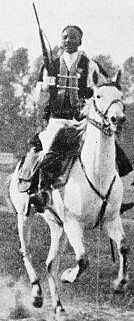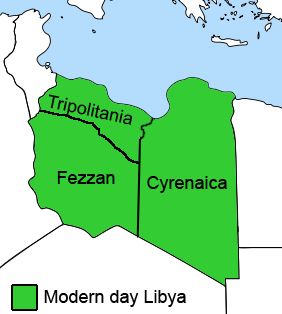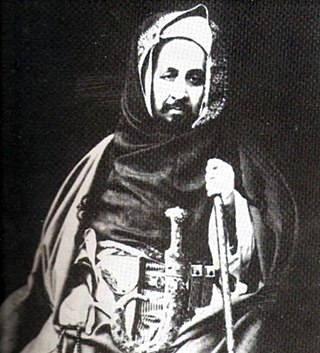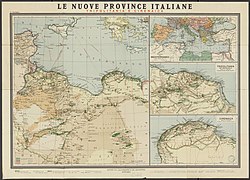
The Senusiyya, Senussi or Sanusi are a Muslim political-religious Sufi order and clan in Libya and surrounding regions founded in Mecca in 1837 by the Grand Sanussi, the Algerian Muhammad ibn Ali al-Sanusi.

Muhammad Idris bin Muhammad al-Mahdi as-Senussi was a Libyan political and religious leader who was King of Libya from 24 December 1951 until his ouster in the 1 September 1969 coup d'état. He ruled over the United Kingdom of Libya from 1951 to 1963, after which the country became known as simply the Kingdom of Libya. Idris had served as Emir of Cyrenaica and Tripolitania from the 1920s until 1951. He was the chief of the Senussi Muslim order.

The Italo-Turkish or Turco-Italian War was fought between the Kingdom of Italy and the Ottoman Empire from 29 September 1911, to 18 October 1912. As a result of this conflict, Italy captured the Ottoman Tripolitania Vilayet, of which the main sub-provinces were Fezzan, Cyrenaica, and Tripoli itself. These territories became the colonies of Italian Tripolitania and Cyrenaica, which would later merge into Italian Libya.

Omar al-Mukhṭār Muḥammad bin Farḥāṭ al-Manifī, called The Lion of the Desert, known among the colonial Italians as Matari of the Mnifa, was an Imam and leader of native resistance in Cyrenaica under the Senussids, against the Italian colonization of Libya. A teacher-turned-general, Omar was a prominent figure of the Senussi movement and is considered the national hero of Libya and a symbol of resistance in the Arab and Islamic worlds. Beginning in 1911, he organised and led the Libyan resistance movement against the Italian colonial empire during the First and Second Italo-Senussi Wars. Externally, he also fought against the French colonization of Chad and the British occupation of Egypt. After many attempts, the Italian Armed Forces managed to capture Al-Mukhtar near Slonta when he was wounded in battle by Libyan colonial troops, and hanged him in 1931 after he refused to surrender.

Jaghbub is a remote desert village in the Al Jaghbub Oasis in the eastern Libyan Desert. It is actually closer to the Egyptian town of Siwa than to any Libyan town of note. The oasis is located in Butnan District and was the administrative seat of the Jaghbub Basic People's Congress. The town remains highly obscure, in spite of the substantial colonial history the city holds. The town was the birthplace of Idris of Libya on 12 March 1890.

Savari was the designation given to the regular native Libyan cavalry regiments of the Italian colonial army from 1912 to 1943, in Italian Tripolitania and Italian Cyrenaica, and later in Italian Libya. The word "savari" was derived from a Persian term for "horsemen" (Savārān).

Ottoman Tripolitania, also known as the Regency of Tripoli, was officially ruled by the Ottoman Empire from 1551 to 1912. It corresponded roughly to the northern parts of modern-day Libya in historic Tripolitania and Cyrenaica. It was initially established as an Ottoman province ruled by a pasha (governor) in Tripoli who was appointed from Constantinople, though in practice it was semi-autonomous due to the power of the local Janissaries. From 1711 to 1835, the Karamanli dynasty ruled the province as a de facto hereditary monarchy while remaining under nominal Ottoman suzerainty. In 1835, the Ottomans reestablished direct control over the region until its annexation by Italy in 1912.

The Italian colonizationof Libya began in 1911 and it lasted until 1943. The country, which was previously an Ottoman possession, was occupied by Italy in 1911 after the Italo-Turkish War, which resulted in the establishment of two colonies: Italian Tripolitania and Italian Cyrenaica. In 1934, the two colonies were merged into one colony which was named the colony of Italian Libya. In 1937, this colony was divided into four provinces, and in 1939, the coastal provinces became a part of metropolitan Italy as the Fourth Shore. The colonization lasted until Libya's occupation by Allied forces in 1943, but it was not until the 1947 Paris Peace Treaty that Italy officially renounced all of its claims to Libya's territory.

This is a survey of the postage stamps and postal history of Tripolitania, now part of Libya.

The military history of Libya covers the period from the ancient era to the modern age.

Libya was a colony of Fascist Italy located in North Africa, in what is now modern Libya, between 1934 and 1943. It was formed from the unification of the colonies of Cyrenaica and Tripolitania, which had been Italian possessions since 1911.
The Libyan Division was a formation of colonial troops raised by the Italians in their colony in Libya. It participated in the invasion of Ethiopia in the Second Italo-Abyssinian War. The formation was reorganized into the 1st Libyan Division by the beginning of Italy's entry into World War II. In September 1940, the 1st Libyan Division, together with its sister-division 2nd Libyan Division, participated in the Italian invasion of Egypt. By December, the division was dug in at Maktila and was forced to surrender during Operation Compass.

Italian Tripolitania was an Italian colony, located in present-day western Libya, that existed from 1911 to 1934. It was part of the territory conquered from the Ottoman Empire after the Italo-Turkish War in 1911. Italian Tripolitania included the western northern half of Libya, with Tripoli as its main city. In 1934, it was unified with Italian Cyrenaica in the colony of Italian Libya. In 1939, Tripolitania was considered a part of the Kingdom of Italy's 4th Shore.

Italian Cyrenaica was an Italian colony, located in present-day eastern Libya, that existed from 1911 to 1934. It was part of the territory conquered from the Ottoman Empire during the Italo-Turkish War of 1911, alongside Italian Tripolitania.

Ahmed Sharif as-Senussi was the supreme leader of the Senussi order (1902–1933), although his leadership in the years 1917–1933 could be considered nominal. His daughter, Fatimah el-Sharif was the Queen consort of King Idris I of Libya.

Italian Spahis were light cavalry colonial troops of the Kingdom of Italy, raised in Italian Libya between 1912 and 1942.

The Tripolitanian Republic, was an Arab republic that declared the independence of Tripolitania from Italian Libya after World War I.

The Second Italo-Senussi War, also referred to as the Pacification of Libya, was a conflict that occurred during the Italian colonization of Libya between Italian military forces and indigenous rebels associated with the Senussi Order. The war lasted from 1923 until 1932, when the principal Senussi leader, Omar al-Mukhtar, was captured and executed. The Libyan genocide took place during and after the conflict.
The Battle of Misrata was fought between Italian and Turkish forces on 9 July 1912 during the Italo-Turkish War. The battle was fought for control of the Tripolitanian town of Misrata, a major supply base for Ottoman forces.
The War in Jebel Akhdar refers to the fighting between Italian soldiers and Senussi rebels near the forested and mountainous areas of the Jebel Akhdar. The attacks by the Italians were initially met by strong guerrilla resistance, but this resistance soon fell as the Battle of Uadi Bu Taga took place. This conflict resulted in the execution of the main Senussi leaders and, subsequently, the end of the Italian pacification campaign.
















